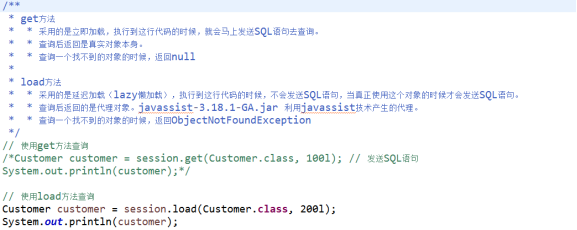####1.1Hibernate框架的学习路线
第一天:Hibernate的入门(Hibernate的环境搭建、Hibernate的API、Hibernate的CRUD)
第二天:Hibernate的一级缓存、其他的API
第三天:Hibernate的一对多配置、Hibernate的多对多的配置
第四天:Hibernate的查询方式、抓取策略
####1.2CRM的案例
1.2.1CRM的概述(了解)
1.2.1.1什么是CRM 客户关系管理
1.2.1.2CRM有哪些模块
#####1.3Hibernate的框架的概述
1.3.1.1什么是框架
框架:指的是软件的半成品,已经完成了部分功能。
1.3.2EE的三层架构
1.3.2.1EE的经典三层结构
ORM:对象关系映射,指的是将一个java中的对象与关系型数据库中的表建立一种映射关系,从而操作对象就可以完成数据库的相关操作
###实例如下:
首先先看下数据库的创造
CREATE TABLE `cst_customer` ( `cust_id` bigint(32) NOT NULL AUTO_INCREMENT COMMENT '客户编号(主键)', `cust_name` varchar(32) NOT NULL COMMENT '客户名称(公司名称)', `cust_source` varchar(32) DEFAULT NULL COMMENT '客户信息来源', `cust_industry` varchar(32) DEFAULT NULL COMMENT '客户所属行业', `cust_level` varchar(32) DEFAULT NULL COMMENT '客户级别', `cust_phone` varchar(64) DEFAULT NULL COMMENT '固定电话', `cust_mobile` varchar(16) DEFAULT NULL COMMENT '移动电话', PRIMARY KEY (`cust_id`)'主键' ) ENGINE=InnoDB AUTO_INCREMENT=1 DEFAULT CHARSET=utf8;
这样就创建了一个数据表
然后就是根据这个数据表创建一个对应的类
public class HibernateDemo1 { private long cust_id; private String cust_name; private String cust_source; private String cust_industry; private String cust_level; private String cust_phone; private String cust_mobile; public long getCust_id() { return cust_id; } public void setCust_id(long cust_id) { this.cust_id = cust_id; } public String getCust_name() { return cust_name; } public void setCust_name(String cust_name) { this.cust_name = cust_name; } public String getCust_source() { return cust_source; } public void setCust_source(String cust_source) { this.cust_source = cust_source; } public String getCust_industry() { return cust_industry; } public void setCust_industry(String cust_industry) { this.cust_industry = cust_industry; } public String getCust_level() { return cust_level; } public void setCust_level(String cust_level) { this.cust_level = cust_level; } public String getCust_phone() { return cust_phone; } public void setCust_phone(String cust_phone) { this.cust_phone = cust_phone; } public String getCust_mobile() { return cust_mobile; } public void setCust_mobile(String cust_mobile) { this.cust_mobile = cust_mobile; } }
下面就是配置类和数据表之间的关联。命名的规则是xxx.hbm.xml文件。习惯上采用类的名字作为命名
首先需要做的是配置映射的关系,映射关系的文件放置在类文件的同级根目录下
<?xml version="1.0" encoding="UTF-8"?> <!DOCTYPE hibernate-mapping PUBLIC "-//Hibernate/Hibernate Mapping DTD 3.0//EN" "http://www.hibernate.org/dtd/hibernate-mapping-3.0.dtd"> <!--以上部分是固定的格式可以在我们的Hibernate的导包中找到--> <!--下面就是开始创建对应的映射关系--> <hibernate-mapping> <!-- 建立类与表的映射 --> <class name="com.hibernate.learn.HibernateDemo1" table="cst_customer"> <!-- 建立类中的属性与表中的主键对应--> <id name="cust_id" column="cust_id"> <generator class="native"></generator> </id> <!-- 建立类中的普通的属性和表中字段的对应。除了主键用id其他都用property --> <property name="cust_name" column="cust_name"></property> <property name="cust_source" column="cust_source"></property> <property name="cust_industry" column="cust_industry"></property> <property name="cust_level" column="cust_level"></property> <property name="cust_phone" column="cust_phone"></property> <property name="cust_mobile" column="cust_mobile"></property> </class> </hibernate-mapping>
至此映射关系配置完毕
下面需要做的是数据库连接的配置文件,这个文件的命名格式是Hibernate.cfg.xml
<?xml version="1.0" encoding="UTF-8"?> <!DOCTYPE hibernate-configuration PUBLIC "-//Hibernate/Hibernate Configuration DTD 3.0//EN" "http://www.hibernate.org/dtd/hibernate-configuration-3.0.dtd"> <!--同样的上面这块属于固定的文件配置,下面的就是Hibernate的相关配置--> <hibernate-configuration> <session-factory> <!-- 连接数据库的基本配置。这块属于数据库的固定配置模式,这里的数据库是mysql数据库--> <property name="hibernate.connection.driver_class">com.mysql.jdbc.Driver</property> <property name="hibernate.connection.url">jdbc:mysql://localhost:3306/test</property> <property name="hibernate.connection.username">root</property> <property name="hibernate.connection.password">root</property> <!-- 配置Hibernate的方言。意思是指你采用的是什么数据库,因为mysql,orcle等很多数据库的要求是不一样的。所以要在此处进行配置 --> <property name="hibernate.dialect">org.hibernate.dialect.MySQLDialect</property> <!-- 打印sql语句到控制台,不是必须要有的配置--> <property name="hibernate.show_sql">true</property> <!-- 自动建表的配置 --> <property name="hibernate.hbm2ddl.auto">update</property> <!-- 配置C3P0连接池 .如果需要使用c3p0可以通过这种方式来完成导入--> <property name="connection.provider_class">org.hibernate.connection.C3P0ConnectionProvider</property> <!--在连接池中可用的数据库连接的最少数目 --> <property name="c3p0.min_size">5</property> <!--在连接池中所有数据库连接的最大数目 --> <property name="c3p0.max_size">20</property> <!--设定数据库连接的过期时间,以秒为单位, 如果连接池中的某个数据库连接处于空闲状态的时间超过了timeout时间,就会从连接池中清除 --> <property name="c3p0.timeout">120</property> <!--每3000秒检查所有连接池中的空闲连接 以秒为单位--> <property name="c3p0.idle_test_period">3000</property> <!-- 格式化sql,是控制台输出的数据库语句更加美观,不是必须要有的配置 --> <property name="hibernate.format_sql">true</property> <!--最终映射到刚刚的类与数据表映射的配置文件xxx.hbm.xml--> <mapping resource="com/hibernate/learn/Hibernate.hbm.xml"></mapping> </session-factory> </hibernate-configuration>
至此Hibernate的相关配置完成
最后开始对数据库经行操作
public static void main(String[] args) throws SecurityException, HeuristicMixedException, HeuristicRollbackException, RollbackException, SystemException { //保存客户的案例 //1.加载Hibernate核心配置文件 Configuration configuration=new Configuration().configure(); //2.创建一个SessionFactory对象:类似于JDBC中连接池 SessionFactory sessionFactory=configuration.buildSessionFactory(); //3.通过SessionFactory获取到Session对象,类似于JDBC中的Connection Session session=sessionFactory.openSession(); //4.手动开启事务: Transaction transaction=(Transaction) session.beginTransaction(); //5.编写代码 HibernateDemo1 hibernateDemo1=new HibernateDemo1(); hibernateDemo1.setCust_name("zyz"); session.save(hibernateDemo1); //6.事务提交 transaction.commit(); //7.释放资源 session.close(); } OK至此相关的简单的案例完成
#####1.5Hibernate的相关配置
###【class标签的配置】
标签用来建立类与表的映射关系
属性:
name :类的全路径
table :表名(类名与表名一致,table可以省略)
catalog :数据库名
###【id标签的配置】
标签用来建立类中的属性与表中的主键的对应关系
属性:
name :类中的属性名
column :表中的字段名(类中的属性名和表中的字段名如果一致,column可以省略)
length :长度
type :类型
###【property标签的配置】
标签用来建立类中的普通属性与表的字段的对应关系
属性:
name :类中的属性名
column :表中的字段名
length :长度
type :类型
not-null :设置非空
unique :设置唯一
#######核心配置
#######必须的配置
连接数据库的基本的参数
驱动类
url路径
用户名
密码
方言
####可选的配置
显示SQL :hibernate.show_sql
格式化SQL :hibernate.format_sql
#####自动建表 :hibernate.hbm2ddl.auto
none :不使用hibernate的自动建表
create :如果数据库中已经有表,删除原有表,重新创建,如果没有表,新建表。(测试)
create-drop :如果数据库中已经有表,删除原有表,执行操作,删除这个表。如果没有表,新建一个,使用完了删除该表。(测试)
update :如果数据库中有表,使用原有表,如果没有表,创建新表(更新表结构)
validate :如果没有表,不会创建表。只会使用数据库中原有的表。(校验映射和表结构)。
映射文件的引入
引入映射文件的位置 <mapping resource="com/hibernate/learn/Hibernate.hbm.xml"></mapping>
#######1.6Hibernate的核心API
####作用:
###加载核心配置文件
hibernate.properties
Configuration cfg = new Configuration();
hibernate.cfg.xml
Configuration cfg = new Configuration().configure();
加载映射文件
// 手动加载映射
configuration.addResource("com/itheima/hibernate/demo1/Customer.hbm.xml");
##########SessionFactory:Session工厂
SessionFactory内部维护了Hibernate的连接池和Hibernate的二级缓存(不讲)。是线程安全的对象。一个项目创建一个对象即可。
<!-- 配置C3P0连接池 --> <property name="connection.provider_class">org.hibernate.connection.C3P0ConnectionProvider</property> <!--在连接池中可用的数据库连接的最少数目 --> <property name="c3p0.min_size">5</property> <!--在连接池中所有数据库连接的最大数目 --> <property name="c3p0.max_size">20</property> <!--设定数据库连接的过期时间,以秒为单位, 如果连接池中的某个数据库连接处于空闲状态的时间超过了timeout时间,就会从连接池中清除 --> <property name="c3p0.timeout">120</property> <!--每3000秒检查所有连接池中的空闲连接 以秒为单位--> <property name="c3p0.idle_test_period">3000</property>
#############Session:类似Connection对象是连接对象
#####Session代表的是Hibernate与数据库的链接对象。不是线程安全的。与数据库交互桥梁。
#####Session中的API
保存方法:
Serializable save(Object obj);
public void test(){ Session session=HibernateUtils.GetSession(); //手动开启事务 Transaction transaction=session.beginTransaction(); HibernateDemo1 hibernateDemo1=new HibernateDemo1(); hibernateDemo1.setCust_name("宋培闯"); session.save(hibernateDemo1); transaction.commit();//事件的提交 session.close();//会话关闭 }
查询方法:
T get(Class c,Serializable id);
T load(Class c,Serializable id);
get方法和load方法的区别?
//使用get的方法进行查询 public void TestDemo2(){ Session session=HibernateUtils.GetSession(); //手动开启事务 Transaction transaction=session.beginTransaction(); //使用get方式查询 HibernateDemo1 hibernateDemo1=new HibernateDemo1(); hibernateDemo1=session.get(HibernateDemo1.class,1l); System.out.println(hibernateDemo1.toString()); transaction.commit();//事件的提交 session.close();//会话关闭 } //使用load方式查询 public void TestLoad(){ Session session=HibernateUtils.GetSession(); //手动开启事务 Transaction transaction=session.beginTransaction(); HibernateDemo1 hibernateDemo1=new HibernateDemo1(); hibernateDemo1=session.load(HibernateDemo1.class,2l); System.out.println(hibernateDemo1.toString()); transaction.commit();//事件的提交 session.close();//会话关闭 }
区别

修改方法
void update(Object obj);
//修改的方法 public void updateTest(){ Session session=HibernateUtils.GetSession(); //手动开启事务 Transaction transaction=session.beginTransaction(); //直接创建对象,进行修改:不推荐使用,因为会导致为设置的值全部变为空 /* HibernateDemo1 hibernateDemo1=new HibernateDemo1(); hibernateDemo1.setCust_id(1l); hibernateDemo1.setCust_name("修改名字"); session.update(hibernateDemo1);*/ //先查询在修改 HibernateDemo1 hibernateDemo1=new HibernateDemo1(); hibernateDemo1=session.get(HibernateDemo1.class,1l); hibernateDemo1.setCust_name("修改名字"); session.update(hibernateDemo1); transaction.commit();//事件的提交 session.close();//会话关闭 }
删除方法
void delete(Object obj);
//删除的方法 public void DeleteTest(){ Session session=HibernateUtils.GetSession(); //手动开启事务 Transaction transaction=session.beginTransaction(); //直接创建对象删除 /*HibernateDemo1 hibernateDemo1=new HibernateDemo1(); hibernateDemo1.setCust_id(1l); session.delete(hibernateDemo1);*/ //先查询再删除,推荐使用这一种方式 HibernateDemo1 hibernateDemo1=new HibernateDemo1(); hibernateDemo1=session.get(HibernateDemo1.class,1l); session.delete(hibernateDemo1); transaction.commit();//事件的提交 session.close();//会话关闭 }
保存或更新
void saveOrUpdate(Object obj)
//保存或更新的方法(不常用) public void TestDemo1(){ Session session=HibernateUtils.GetSession(); //手动开启事务 Transaction transaction=session.beginTransaction(); //如果数据库中没有这条数据就是添加,如果有这条数据,那就是修改 HibernateDemo1 hibernateDemo1=new HibernateDemo1(); hibernateDemo1.setCust_name("testets"); session.saveOrUpdate(hibernateDemo1); transaction.commit();//事件的提交 session.close();//会话关闭 }
//查询所有的信息 public void TestDemo03(){ Session session=HibernateUtils.GetSession(); //手动开启事务 Transaction transaction=session.beginTransaction(); //接收HQL:hibernate Query Language 面向对象的查询语句 /*org.hibernate.Query query=session.createQuery("from HibernateDemo1"); List<HibernateDemo1> list=query.list(); for(HibernateDemo1 hibernateDemo1:list){ System.out.println(hibernateDemo1.toString()); }*/ //接收SQL SQLQuery query=session.createSQLQuery("select *from cst_customer"); List <Object[]> list=query.list(); for(Object[] objects:list){ System.out.println(Arrays.toString(objects)); } transaction.commit();//事件的提交 session.close();//会话关闭 }
其中HibernateUtils代码如下
import org.hibernate.Session; import org.hibernate.SessionFactory; import org.hibernate.cfg.Configuration; public class HibernateUtils { //这个包的主要重用是为了放置工具类 //这个工具类是Hibernate的工具类 public static final Configuration cfg; public static final SessionFactory sf;//创建一个SessionFactory对象:类似于JDBC中连接池 static{ //加载Hibernate核心配置文件 cfg=new Configuration().configure(); sf=cfg.buildSessionFactory();//此处相当于创建工厂 } //对外设置一个接口 public static Session GetSession(){ //通过SessionFactory获取到Session对象,类似于JDBC中的Connection return sf.openSession(); } }